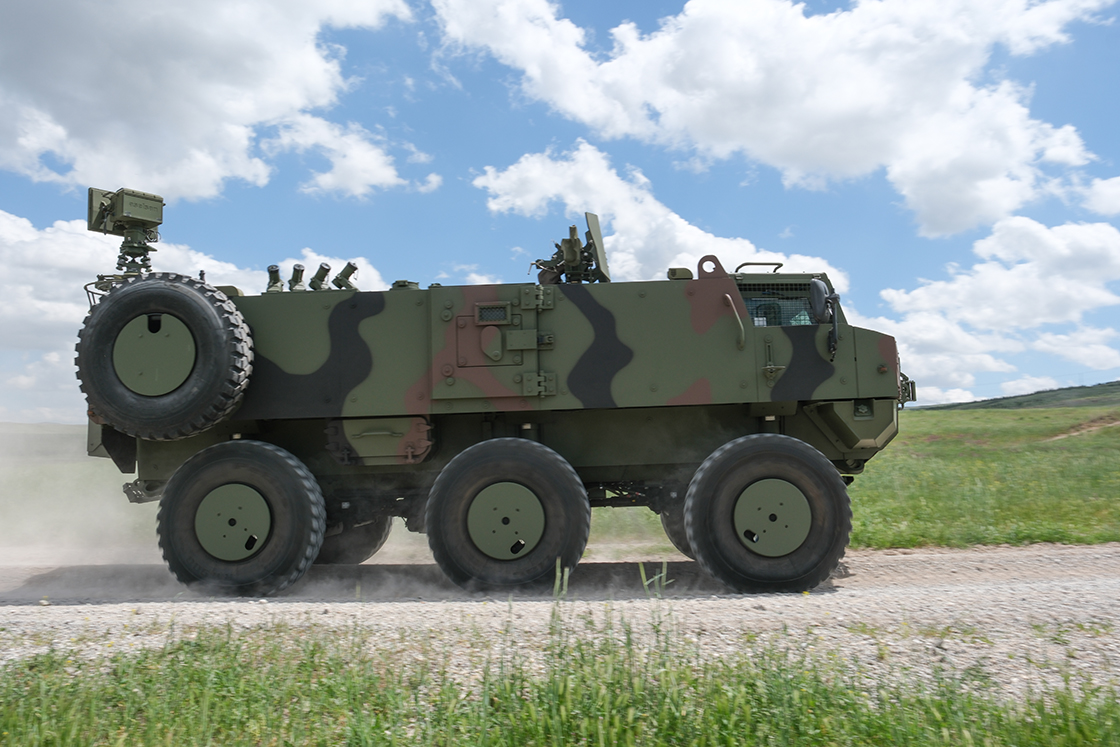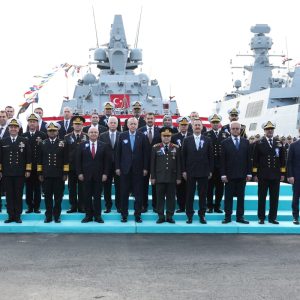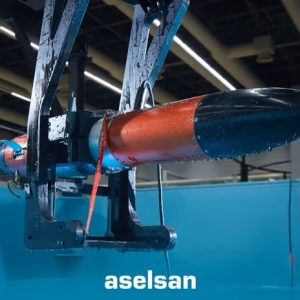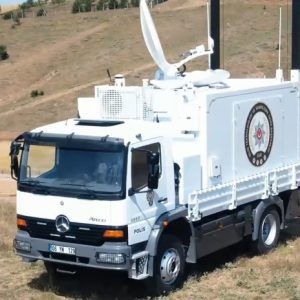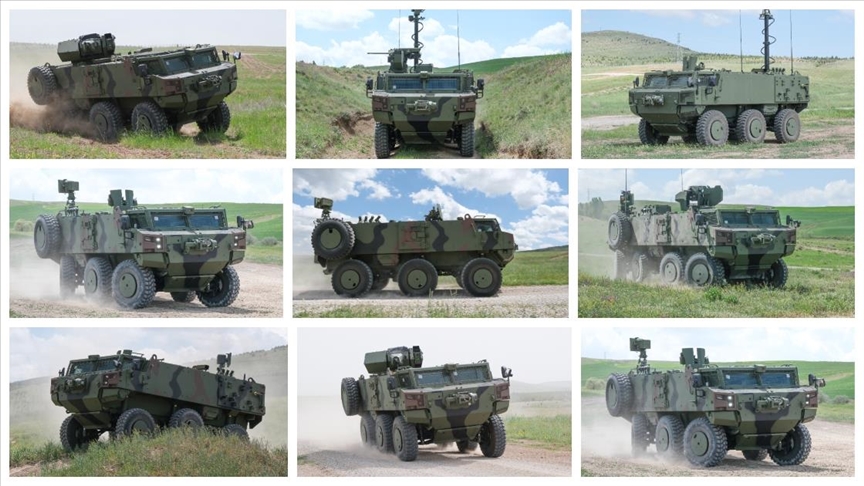
Türkiye has inducted PARS İZCİ 6×6 and 8×8 reconnaissance and mission‑specific armored vehicles into the Turkish Land Forces (TSK). The Ministry of National Defence announced the decision at its weekly briefing. The fleet brings multi‑sensor fusion, modern command‑and‑control (C2), and fast wheeled mobility. As a result, units gain quicker and safer situational awareness at the tactical edge.[1]
Key Facts
• Family: PARS İZCİ 6×6 and 8×8 under the ÖMTTZA programme.[3],[4]
• Roles: sensor reconnaissance, radar carrier, command/CP nodes; additional mission variants planned.[1],[4]
• Mobility: ~100 km/h road speed; 60% grade, 30% side‑slope, 0.7 m obstacle, 1.4 m trench (FNSS data).[5]
• Protection: modular armor and mine protection aligned with modern wheeled IFV expectations; scalable via kit.[4],[5]
• C2: network‑centric architecture to push intelligence to the tactical edge.[1]
Why this induction matters now
First, the batch covers sensor reconnaissance, radar, and command variants. These platforms deliver all‑weather surveillance and unit‑level C2 on protected, wheeled carriers. Second, under the ÖMTTZA programme, FNSS tailored payloads and mission kits to TSK needs, creating five variants; four form a standard reconnaissance team.[1],[3],[4]
Importantly, the programme also introduces an 8×8 class into the Land Forces for the first time. This step raises payload capacity, internal volume, and growth margin across the fleet.[2]
Operational impact: from scouting to sensor‑led maneuver
On PARS İZCİ 6×6 and 8×8, sensing, processing, and command sit on the same protected node. Therefore teams can scan routes, watch key areas, and cue fires while staying connected through secure radios and battle‑management systems. This design shifts reconnaissance from platform‑centric activity to a networked, sensor‑led approach.[1],[4]
For example, radar variants extend detection in fog, rain, and dust. Electro‑optical suites provide day/night imagery and tracking. Command variants fuse these feeds to support company‑ and battalion‑level actions. Meanwhile, wheeled mobility allows long road moves with a lighter logistics tail than tracked assets.[4],[5]
Why 6×6 and 8×8 together?
Fielding both PARS İZCİ 6×6 and 8×8 gives commanders choice. The 6×6 offers lower weight, a tighter turning circle, and strong mobility in urban or complex terrain.
By contrast, the 8×8 adds volume and payload for heavier sensors, extra power, and future kits. Consequently, task‑organized teams can balance mobility, endurance, and payload without losing subsystem commonality.[4],[5]
Variants and mission systems
Within the ÖMTTZA baseline, FNSS configured five variants. Four cluster into the reconnaissance team: a sensor reconnaissance carrier, a radar platform, a command/CP vehicle, and a support element. Public data also points to PARS‑based CBRN reconnaissance, which shows the modular, open approach that can host specialist kits when required.[1],[6]
Manufacturer data indicates highway speeds up to about 100 km/h, 60% gradient and 30% side‑slope climbing. In practice, these figures enable quick moves between observation posts while keeping crews protected.[5]
Doctrine: recon pull, not push
These additions support a shift toward “reconnaissance pull.” In this model, commanders shape maneuver based on fresh reconnaissance rather than a fixed plan. UAVs, artillery observers, and PARS İZCİ 6×6 and 8×8 create a sensor web. Consequently, units see gaps earlier and act sooner.[1],[4]
For NATO missions and training, wheeled range and strategic mobility also matter. The platforms can deploy easily to allied areas and exercises. They match allied trends that value protected mobility, modular payloads, and software‑defined radios in reconnaissance forces.
Industrial and programmatic context
FNSS manufactures the vehicles under the ÖMTTZA contract. The programme emphasises modularity and local content, which supports supply‑chain resilience and lifecycle control. Notably, the 8×8 class now enters TSK service, creating a base for future mission variants and upgrades.[2],[4]
Interoperability and the sensor web
As counter‑UAS, electronic warfare, and long‑range fires expand, PARS İZCİ 6×6 and 8×8 add organic sensor apertures at brigade and division levels. Their feeds can link with UAV ISR and ground radars. In internal security roles, they serve as mobile observation and command posts. Crucially, protected mobility lets them “stay and sense.”[4],[5]
What to watch next
Two items merit close watch. First, the delivery pace and the 6×6/8×8 mix will set sensor and C2 density at unit level. Second, the roadmap for counter‑UAS, electronic support, and beyond‑line‑of‑sight comms will show how far the fleet can extend the reconnaissance bubble and feed joint fires.[4],[5]
Internal context
For broader context on land modernisation and ISR, see our DSEI coverage this season.[7]
References
- AA report on the MSB briefing and vehicle induction (“Mekanize piyadenin ufku gören gözleri envantere girdi”). Link.
- AA coverage quoting programme leadership on the ÖMTTZA/8×8 entry into TSK inventory. Link.
- FNSS product page: PARS İZCİ (TR). Link.
- FNSS product page: PARS SCOUT 6×6 (EN). Link.
- PARS SCOUT 6×6/8×8 technical brochure (spec values). Link.
- Background: FNSS CBRN reconnaissance variant (precedent for modular payloads). Link.
- Internal link — Defence Agenda DSEI 2025 round‑up (context). Link.
Further Reading
- MSB: Weekly press briefing highlights (official channel). Link
- Defensehere: FNSS delivers 6×6 and 8×8 vehicles to TSK. Link
- DefenceTürk: PARS İZCİ in the Land Forces. Link
Internal link: For allied trends and market signals intersecting with Türkiye’s programmes, read our DSEI 2025 coverage here.

